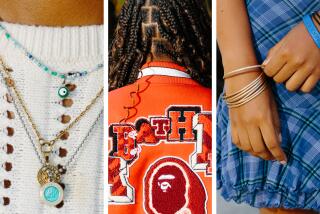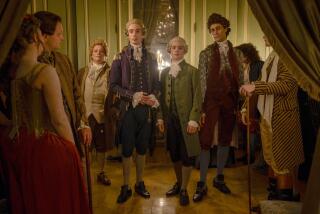Men’s Q & A : Clothes May Make or Break Job Interview
- Share via
Luciano Franzoni is a fashion consultant for Hartmarx Corp., the country’s largest supplier of men’s tailored clothing. Here, he talks to Fashion85 about dressing for a job interview.
Question: For an interview for a man’s first job, would you suggest a suit or a sport coat and trousers?
Answer: It depends on the type of job the young man is seeking and on local climatic situations. Clothes that are accepted in Los Angeles, for example, are not necessarily accepted in Boston. If the man chooses a sport coat, he should either wear a solid color or a very minute pattern with nothing flamboyant in terms of color.
Q: What color do you recommend?
A: For a sport coat, my No. 1 choice is navy, followed by medium blue, dark-to-medium grays and the universal camel. I call these the safe colors--especially when camel is called khaki. Studies show that these colors are the least conspicuous and that anyone who is too conspicuous on an interview can generate negative vibrations.
If the position the young man is applying for calls for a suit, I would use the same palette, and, in terms of patterns, I wouldn’t hesitate to venture out of the traditional pin stripes and adopt a faint, muted plaid because a young man can more easily wear patterns than the boss.
Q: How many buttons should the sport coat or suit have?
A: A two-button, single-breasted style is preferred for both. However, there are on the market double-breasted styles that have quite a traditional silhouette, and these too would be acceptable. Three years ago, a double-breasted suit would have been out of the question, but right now it’s part of the mainstream of business clothing.
Q: What is the fashionable width for lapels right now?
A: Moderately wide, from 3 1/2 to four inches in width. Two or three years ago, lapels were slightly narrower. As the silhouette loosened, the lapels widened. It’s a matter of harmony.
Q: Should the pant legs be cuffed or uncuffed?
A: I would leave the decision to the interviewee because it’s not sartorially relevant. Right now, as a matter of trivia, there are two schools of thought on cuffs. One school has it that cuffs are worn mainly by the stubborn traditionalist who always has worn them. The other school of cuff wearers includes the avant-garde dresser, who finds cuffs to be a novelty and therefore “good.” In the middle are the vast majority of men who detest cuffs and never wear them.
Q: If the job seeker elects to wear cuffs, how wide should they be?
A: They should be about 1 1/2 inches wide.
Q: What style and collar of shirt are right?
A: Depending on the style of the coat, there are five shirt collars considered appropriate. A collar-pin collar is worn when a more formal look is desired. For example, if the man were applying for a job with a financial institution. The cutaway collar, also quite dressy, was popularized by the Duke of Windsor. The straight-point collar is the most versatile and can be worn for dress or sport, day or night. The button-down is primarily sporty and worn in the daytime, but the stubborn traditionalist wears it at night as well. To round it out, the rounded collar gives a soft look and can be worn for dress or sport. In terms of color, the best choices are white, off-white, ecru and soft pastels. The young man may wear soft pink if he likes it.
Q: What ties are the most helpful in getting a job?
A: If you want to be classified by your educational background, wear an old-school tie--providing it’s fresh, no gravy stains. Otherwise, adopt either solid colors or small patterns. Because the interviewee is young, I would also definitely consider wearing pastel shades.
Q: How about shoes?
A: First, look at the heels of your shoes, and make sure that they are not worn out or worn down. That little detail proves that you pay attention to all the components of your apparel. Choose very simple styles. They are not only a good investment, they don’t detract from what you’re wearing. A contemporary version of the laced shoe is suitable.
Q: Is there any one tip that you believe is essential to any well-dressed job hunter?
A: Hartmarx has produced a booklet called “Looking the Part” that gives basic, down-to-earth suggestions on how to project a good image with your clothes. You can get it, free of charge, by writing to the Public Relations Department, Hartmarx, 101 N. Wacker Drive, Chicago, Ill. 60606.
More to Read
Sign up for Essential California
The most important California stories and recommendations in your inbox every morning.
You may occasionally receive promotional content from the Los Angeles Times.













